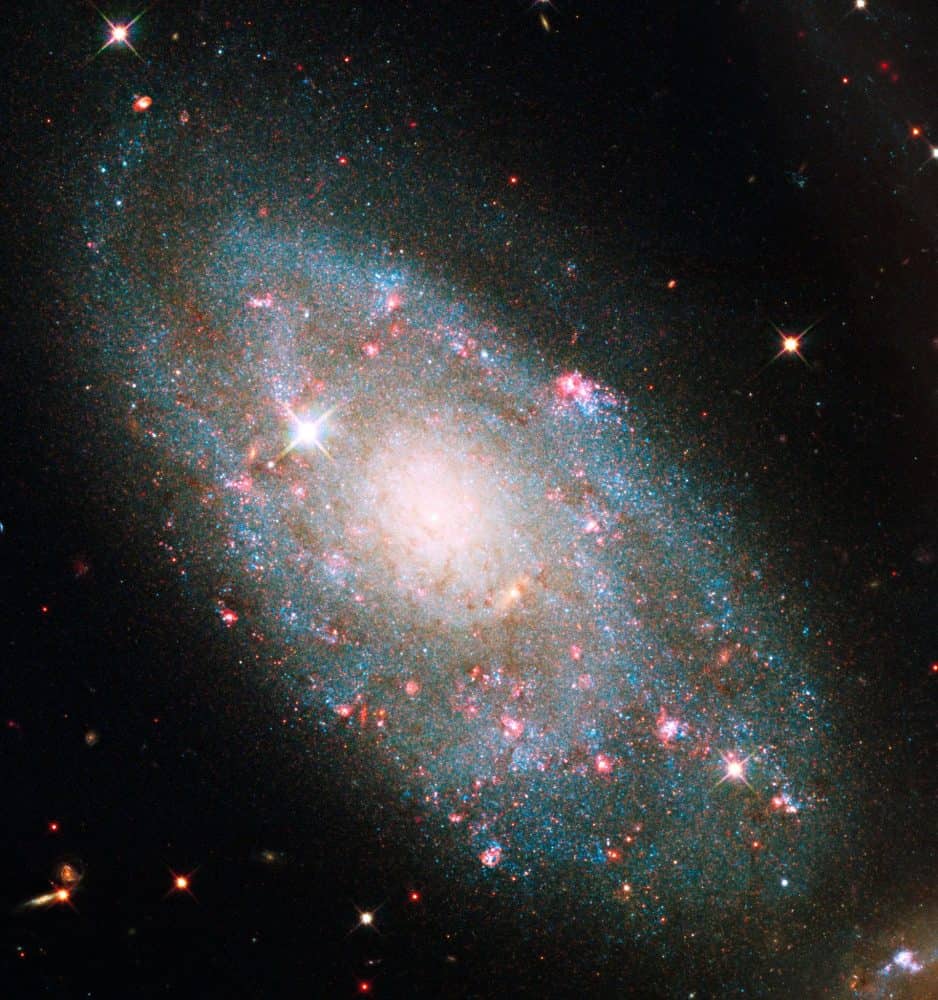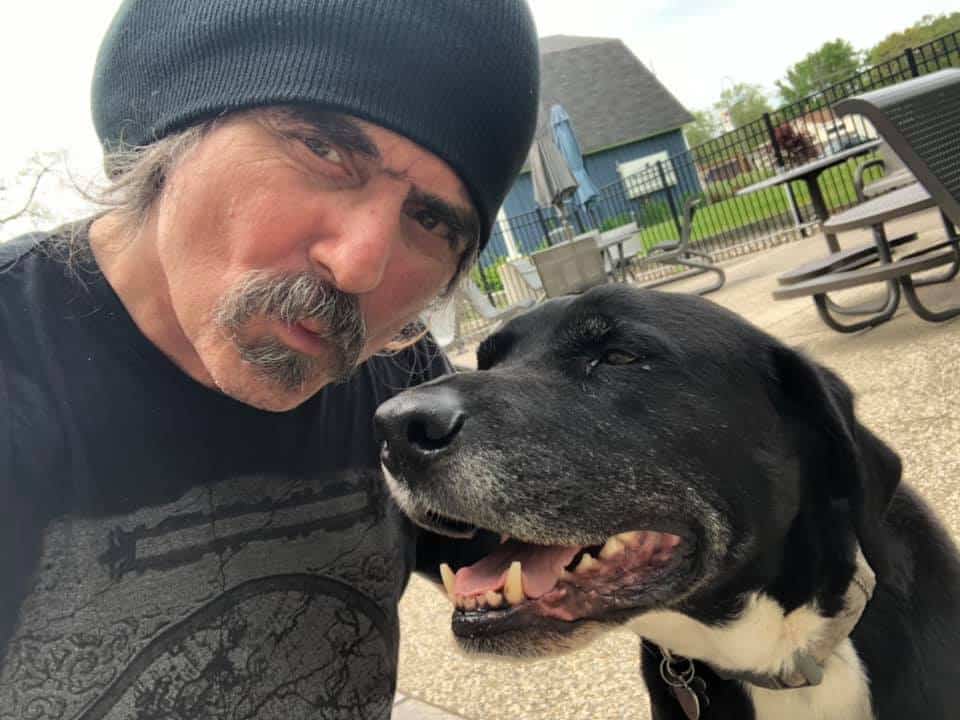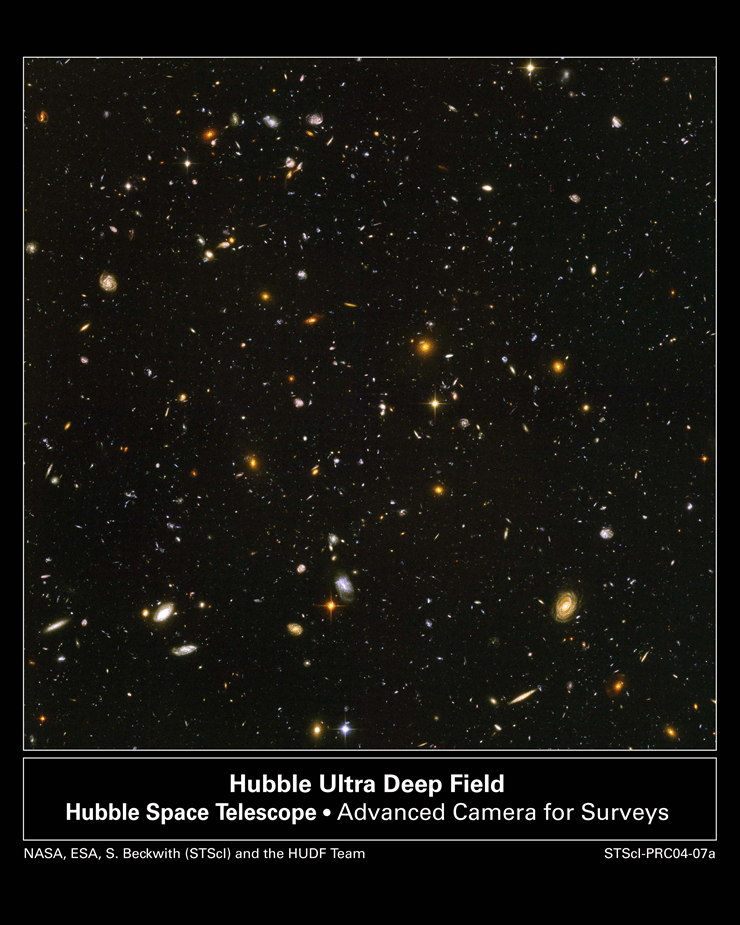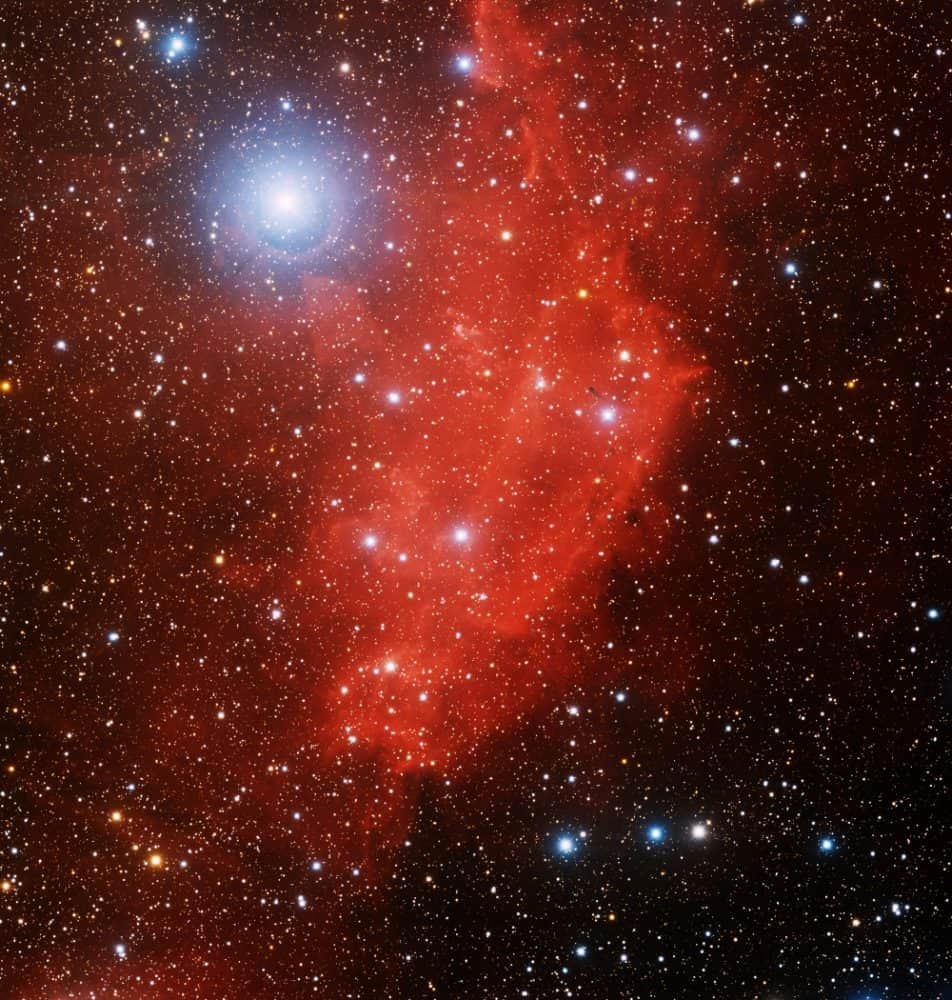Blog
https://www.youtube.com/watch?v=i2eenLfCw-c
more...NGC 7320 is a spiral galaxy in the Stephan’s Quintet. However, it is not an actual member of the galaxy group, but a much closer line-of-sight galaxy at a distance of about 40 million light years. Other galaxies of Stephan’s Quintet are some 300 million light-year distant.
more...Wallace Roney (born May 25, 1960, Philadelphia) is an American jazz (hard bop and post-bop) trumpeter.[1]
Roney took lessons from Clark Terry and Dizzy Gillespie and studied with Miles Davis from 1985 until the latter’s death in 1991. Wallace credits Davis as having helped to challenge and shape his creative approach to life as well as being his music instructor, mentor, and friend; he was the only trumpet player Davis personally mentored.
Roney was born in Philadelphia and attended Howard University and Berklee College of Music in Boston, Massachusetts, after graduating from the Duke Ellington School of the Arts of the D. C. Public Schools, where he studied trumpet with Langston Fitzgerald of the Baltimore Symphony Orchestra. Found to have perfect pitch at the age of four, Wallace began his musical and trumpet studies at Philadelphia’s Settlement School of Music.
He studied with trumpeter Sigmund Hering of the Philadelphia Orchestra for three years. Hering regularly presented Wallace at recitals at the Settlement School, and with the Philadelphia Brass Ensemble, during his studies in Philadelphia.
more...Jimmy Hamilton (May 25, 1917 – September 20, 1994) was an American jazz clarinetist, tenor saxophonist, arranger, composer, and music educator, best known for his twenty-five years with Duke Ellington.
Hamilton was born in Dillon, South Carolina, and grew up in Philadelphia. Having originally learned to play piano and brass instruments, in the 1930s he started playing the latter in local bands, before switching to clarinet and saxophone. In 1939 he played with Lucky Millinder, Jimmy Mundy, and Bill Doggett, going on to join the Teddy Wilson sextet in 1940. After two years with Wilson, he played with Eddie Heywood and Yank Porter.
In 1943, he replaced Barney Bigard in the Duke Ellington orchestra, and stayed with Ellington until 1968. His style was very different on his two instruments: on tenor saxophone he had an R&B sound, while on clarinet he was much more precise and technical. He wrote some of his own material in his time with Ellington.
After he left the Ellington orchestra, Hamilton played and arranged on a freelance basis, before spending the 1970s and 1980s in the Virgin Islandsteaching music. On his retirement from teaching he continued to perform with his own groups in 1989 and 1990. Hamilton died September 20, 1994 in St. Croix, Virgin Islands, at the age of 77.
more...Bill “Bojangles” Robinson (May 25, 1877 – November 25, 1949 Richmond, VA) was an American tap dancer and actor, the best known and most highly paid African-American entertainer in the first half of the twentieth century. His long career mirrored changes in American entertainment tastes and technology. He started in the age of minstrel shows and moved to vaudeville, Broadway, the recording industry, Hollywood, radio, and television. According to dance critic Marshall Stearns, “Robinson’s contribution to tap dance is exact and specific. He brought it up on its toes, dancing upright and swinging”, giving tap a “…hitherto-unknown lightness and presence.”:pp. 186–187 His signature routine was the Stair Dance, in which Robinson would tap up and down a set of stairs in a rhythmically complex sequence of steps, a routine that he unsuccessfully attempted to patent. Robinson is also credited with having introduced a new word, copasetic, into popular culture, via his repeated use of it in vaudeville and radio appearances.
A popular figure in both the black and white entertainment worlds of his era, he is best known today for his dancing with Shirley Temple in a series of films during the 1930s, and for starring in the musical Stormy Weather (1943), loosely based on Robinson’s own life, and selected for preservation in the National Film Registry. Robinson used his popularity to challenge and overcome numerous racial barriers, including becoming the following:
- one of the first minstrel and vaudeville performers to appear without the use of blackface makeup
- one of the earliest African-American performers to go solo, overcoming vaudeville’s two-colored rule
- a headliner in Broadway shows
- the first African American to appear in a Hollywood film in an interracial dance team (with Temple in The Little Colonel, 1935)
- the first African American to headline a mixed-race Broadway production
During his lifetime and afterwards, Robinson also came under heavy criticism for his participation in and tacit acceptance of racial stereotypes of the era, with critics calling him an Uncle Tom figure. Robinson resented such criticism, and his biographers suggested that critics were at best incomplete in making such a characterization, especially given his efforts to overcome the racial prejudice of his era. In his public life Robinson led efforts to:
- persuade the Dallas police department to hire its first African-American policemen
- lobby President Franklin Delano Roosevelt during World War II for more equitable treatment of African-American soldiers
- stage the first integrated public event in Miami, a fundraiser which, with the permission of the mayor, was attended by both black and white city residents
Despite being the highest-paid black performer of the era, Robinson died penniless in 1949, and his funeral was paid for by longtime friend Ed Sullivan. Robinson is remembered for the support he gave to fellow performers, including Fred Astaire, Lena Horne, Jesse Owens, and the Nicholas brothers.
more...Malaysian ensemble
more...3,000 galaxies, large and small, shapely and amorphous, burning in the depths of space. The stunning image was called the Hubble Deep Field.
In subsequent years, Hubble teamed with other observatories to examine small patches of the sky in high resolution, long exposures, and multiple wavelengths. The deeper Hubble sees into space, the farther it gazes back in time. This chart illustrates the regions that have fallen under Hubble’s eye.
Surveys like the Hubble Ultra Deep Field (HUDF) and the Great Observatories Origins Deep Survey (GOODS) have provided pictures of vast, deep collections of galaxies – including some that existed when the universe was less than a billion years old.
The images allow us to follow the development of the universe. Tiny red dots — early, shapeless galaxy building blocks whose light has been stretched by the expanding universe into an infrared glow – litter the most distant parts of the visible universe. Closer in, we see numerous galaxy interactions and collisions as galaxies come together and merge, growing in the process. And nearer still, we see versions of the large, stately galaxies we know today.
more...Bob Dylan (born Robert Allen Zimmerman on May 24, 1941 Duluth, MN) is an American singer-songwriter, author, and visual artist who has been a major figure in popular culture for six decades. Much of his most celebrated work dates from the 1960s, when songs such as “Blowin’ in the Wind” (1963) and “The Times They Are a-Changin’” (1964) became anthems for the Civil Rights Movement and anti-war movement. His lyrics during this period incorporated a wide range of political, social, philosophical, and literary influences, defied pop-music conventions and appealed to the burgeoning counterculture.
Following his self-titled debut album in 1962, which mainly comprised traditional folk songs, Dylan made his breakthrough as a songwriter with the release of The Freewheelin’ Bob Dylan the following year. The album featured “Blowin’ in the Wind” and the thematically complex “A Hard Rain’s a-Gonna Fall“. For many of these songs he adapted the tunes and sometimes phraseology of older folk songs. He went on to release the politically charged The Times They Are a-Changin’ and the more lyrically abstract and introspective Another Side of Bob Dylan in 1964. In 1965 and 1966, Dylan encountered controversy when he adopted electrically amplified rock instrumentation, and in the space of 15 months recorded three of the most important and influential rock albums of the 1960s: Bringing It All Back Home (1965), Highway 61 Revisited (1965) and Blonde on Blonde (1966). The six-minute single “Like a Rolling Stone” (1965) radically expanded what a pop song could convey.
In July 1966, Dylan withdrew from touring after being injured in a motorcycle accident. During this period he recorded a large body of songs with members of the Band, who had previously backed him on tour. These recordings were released as the collaborative album The Basement Tapes, in 1975. In the late 1960s and early 1970s, Dylan explored country music and rural themes in John Wesley Harding (1967), Nashville Skyline (1969), and New Morning (1970). In 1975, he released Blood on the Tracks, which many saw as a return to form. In the late 1970s, he became a born-again Christian and released a series of albums of contemporary gospel music before returning to his more familiar rock-based idiom in the early 1980s. The major works of his later career include Time Out of Mind (1997), “Love and Theft” (2001), Modern Times (2006) and Tempest (2012). His most recent recordings have comprised versions of traditional American standards, especially songs recorded by Frank Sinatra. Backed by a changing lineup of musicians, he has toured steadily since the late 1980s on what has been dubbed the Never Ending Tour.
Since 1994, Dylan has published eight books of drawings and paintings, and his work has been exhibited in major art galleries. He has sold more than 100 million records, making him one of the best-selling music artists of all time. He has also received numerous awards including ten Grammy Awards, a Golden Globe Award, and an Academy Award. Dylan has been inducted into the Rock and Roll Hall of Fame, Minnesota Music Hall of Fame, Nashville Songwriters Hall of Fame, and the Songwriters Hall of Fame. The Pulitzer Prize jury in 2008 awarded him a special citation for “his profound impact on popular music and American culture, marked by lyrical compositions of extraordinary poetic power”. In 2012, Dylan received the Presidential Medal of Freedom, and in 2016, he was awarded the Nobel Prize in Literature “for having created new poetic expressions within the great American song tradition”.
more...Archie Shepp (born May 24, 1937) is an American jazz saxophonist.
Shepp was born in Fort Lauderdale, Florida, but raised in Philadelphia, Pennsylvania. He studied piano, clarinet, and alto saxophone before focusing on tenor saxophone. He occasionally plays soprano saxophone and piano. He studied drama at Goddard College from 1955 to 1959.
He played in a Latin jazz band for a short time before joining the band of avant-garde pianist Cecil Taylor. Shepp’s first recording under his own name, Archie Shepp – Bill Dixon Quartet, was released on Savoy Records in 1962 and featured a composition by Ornette Coleman. Along with John Tchicaiand Don Cherry, he was a member of the New York Contemporary Five. John Coltrane‘s admiration led to recordings for Impulse! Records, the first of which was Four for Trane in 1964, an album of mainly Coltrane compositions on which he was joined by trombonist Roswell Rudd, bassist Reggie Workman and alto player John Tchicai.
more...https://www.youtube.com/watch?v=0XHJvRr7TR4&list=PLF183036912DCA301&index=2&t=0s
more...This image was obtained with the wide-field view of the Mosaic camera on the Mayall 4-meter telescope at Kitt Peak National Observatory. Sh2-282 is an HII emission nebula. The red hydrogen gas is energized by the intense light from the bright blue stars that surround it. Several pillars can be seen embedded in the gas that are being sculpted from the radiation and solar wind from the bright blue star in the upper-left corner of the image. The image was generated with observations in the B (blue), I (orange) and Hydrogen-Alpha (red) filters. In this image, North is up, East is to the left.
Sh2 -282 is a visible emission nebula in the constellation of the Unicorn .
It is observed in the central-northern part of the constellation, about 3 ° south of the Rosetta Nebula ; it can be photographed with some difficulty through a high-powered amateur telescope equipped with special filters and long exposures are required. Being only 1.5 degrees north, it can be observed from all populated areas of the Earth with ease; the most favorable period for its observation in the evening sky is from December to April.
It is an H II region extended for about 50 light years , inside which several cometary structures are known, which indicate the presence of erosive phenomena caused by the stellar wind of the nearest massive spectral stars O and B, and in particular of HD 47432, a variable bluepulsating giant visible on the northeastern side of the nebula; this star has an average magnitude of 6.21 and is located at a distance of 1250 parsecs (4075 light years). The cloud is in the same galactic environment as the Monoceros OB2 association, linked to the Rosetta Nebulaand located on the inner edge of the Perseus Arm , and of which the HD 47432 star would also be a part; the nebulous system also includes NGC 2282 , a reflection nebula placed a little further to the east.
more...Famoudou Don Moye, (born May 23, 1946) is an American jazz percussionist and drummer. He is most known for his involvement with the Art Ensemble of Chicago and is noted for his mastery of African and Caribbean percussion instruments and rhythmic techniques.
https://www.youtube.com/watch?v=LpzxqsrpAb4
more...
Leslie Spann Jr. (May 23, 1932 – January 24, 1989) was an American jazz guitarist and flautist. Les Spann was born in Pine Bluff, Arkansas. From 1950–1957, he studied music at Tennessee State University. At the end of that time he worked with Phineas Newborn Jr. and in 1958 with Ronnell Bright. The following year, he joined a quintet in New York City led by Dizzy Gillespie, performing solos on flute and guitar and appearing on two of Gillespie’s albums for Verve Records. After a year with Gillespie, he went to Europe as a member of Quincy Jones‘s big band. Two more albums followed, this time with Spann joining a sextet that included Duke Ellington, Johnny Hodges, and Harry “Sweets” Edison. He recorded with Hodges again in 1967, then disappeared from the music world. He died in New York City in 1989.
As a sideman he recorded with Nat Adderley, Benny Bailey, Bill Coleman, Eddie “Lockjaw” Davis, Curtis Fuller, Red Garland, Benny Goodman, Sam Jones, Abbey Lincoln, Charles Mingus, Duke Pearson, Jerome Richardson, Charlie Shavers, Sonny Stitt, Billy Taylor, Randy Weston, and Ben Webster. As a leader he recorded only once, the album Gemini in 1960.
more...https://www.youtube.com/watch?v=vp9y0Sj-fdM
more...Researchers at the University of Bonn in Germany and the Russian Academy of Sciences have spotted an incredibly unusual and rare star in the middle of a cloud of gas around 10,000 light years from Earth.
The star, dubbed J005311, appears to have risen from its cosmic grave after two dead stars collided with one another in the constellation Cassiopeia. The findings, published in Nature on May 21, reveal the nature of the exotic zombie star and its unusual properties. The team discovered the bizarre object using data from NASA’s Wide-field Infrared Survey Explorer (WISE) space telescope and subsequently observed it using a ground-based telescope at Russia’s Special Astrophysical Observatory.
At the end of a small star’s lifetime, when all of its fuel has been exhausted, it turns into a “white dwarf” — a tiny, dense, dead star. For the most part, a white dwarf is done for after that. However, researchers at Bonn examined the radiation emitted by the strange star and found that it was lacking in both hydrogen and helium, usually present in a white dwarf.
Due to J005311’s unusual emission signal, the researchers suspect what they’ve detected is the result of a cosmic fusion between two white dwarfs that circled one another for billions of years.
more...More Posts
- Curly Russell Day
- World Music with L’Arpeggiata
- Daily Roots with Lester Sterling
- The Cosmos with NGC 6902
- Andy Narell Day
- Bill Frisell Day
- Wilson Pickett Day
- World Music with Kailash Sharma
- Daily Roots with Karl Bryan & The Afrokats
- Happy St Patricks Day 2019
- The Cosmos with NGC 6188
- Love Lee Day
- Nat King Cole Day
- Sayed Darwish Day
- World Music with the Chieftains and Sinead O’Connor
- Daily Roots with the New Establishment
- The Cosmos with NGC 3324
- Jerry Jeff Walker Day
- Fred Neil Day
- Tommy Flanagan Day




